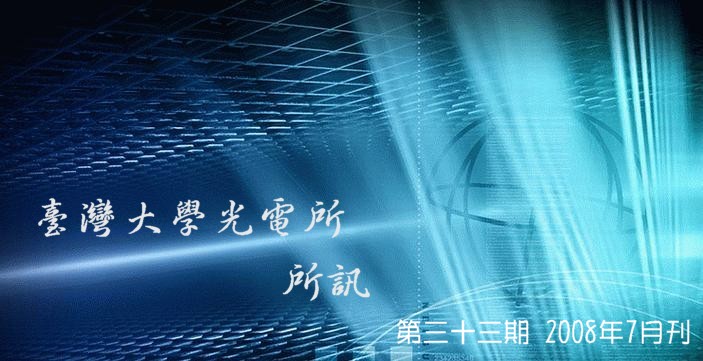 |
||||||||||||||||||
|
|
||||||||||||||||||
|
发行人:黄升龙所长 编辑委员:蔡睿哲教授 主编:林筱文 发行日期:2008.07.07 |
||||||||||||||||||
|
时间:2008年6月13日下午4点30分~6点30分 讲者:Dr.
Jean-Pierre Monchalin
(Group
Leader, Optical Diagnostics of Materials, Modelling and Diagnostics,
Industrial Materials Institute, National Research Council of Canada,
Canada) Dr. Jean-Pierre Monchalin 于2008年6月13日(星期五)莅临本所访问,并于博理馆101演讲厅发表演说,讲题为「Optical Coherence Tomography and Ultrasound Modulated Optical Imaging at the Industrial Materials Institute of the National Research Council of Canada」,本所教师及学生皆热烈参与演讲活动,获益良多。
|
||||||||||||||||||
|
~与南京大学(Nanjing University) 博士生交流活动 2008 ~
【2008 第一届台湾大学—南京大学光学微结构与激光技术博士生论坛】 (时间:2008年5月19日至5月20日;地点:台湾大学) 花絮整理:光电所博士班学生卢彦丞(代表团学生副队长) 很荣幸能参加这次和南京大学物理系的交流活动,历经数月的准备和几经波折,来自南京大学的老师和同学们终于在五月十八日来到台湾,研讨会如期地在十九日展开。这次的交流活动分成三大部分 :学术研讨会、实验室参观和文化之旅。行程如下:
在黄升龙所长、林恭如副所长和林筱文小姐的协助,及各位队员的努力下,这次的交流活动,对南大和台大的同学们而言,均是一个充满知性及感性、寓乡土人文于科学交流的旅程。这次参与的同学有:许森明(队长)、赵家忻、郑行杰、林昌廷、黄政杰、裴善庄、陈正彬、游政卫和我。李光立因家中突然有事,无法参加交流活动,但我们仍感谢他在筹备期间为我们设讨的精美海报及名牌。最后,要感谢的是临危受命,递补光立的邱南福学长。
没吃过猪肉,也看过猪走路。只看过猪走路,大概永远也不会知道猪肉的味道。相信很多同学对于参加学术研讨会已是习以为常的事了,但是,筹备研讨会对大多数的同学而言却是不曾有过的经验。这次的研讨会虽然只是个二十几人的小型研讨会,和国际会议动辄数百人的规模无法相提并论,但藉由筹备这次的研讨会和整个交流活动的行程,让我了解到要使整个会议圆满顺利,所要注意的事情是比我一开始预期来的多很多,整个筹备过程对我而言确实是受益良多。另外,看到我们不少同学可以如数家珍地把台北甚至是台湾的特色娓娓道来,让平日只往返家里和学校两地的我感到十分地汗颜。昌廷对新竹一带的地理位置及台湾产业均相当熟悉;善庄和正彬则对台湾著名的景点及美食了如指掌;行杰更是位杰出的导游,在路上听他为南大的同学介绍台湾的种种,让我不得不对他肃然起敬。其实,这次的实验室参观和文化之旅,有许多地方是我不曾去过或是很久没去的,真的要感谢安排行程的同学,安排这样多彩多姿的行程。经过这次的交流活动,也让我对生活有着另一层次的体会。
和大陆的学生交流,最敏感的话题莫过于两岸问题。相信大家也都很好奇,关于这类的话题,我们是如何应对。基本上,不论是这次南大的同学来台参访还是我们去年去大陆北京、清华大学参加研讨会,大陆的同学几乎都不太会主动提及这类的话题;当然,我们也不会主动去提。这大概就是最近很流行的「搁置争议、共创双赢」吧。和他们交流在这方面,真的是须特别小心,深怕一个不小心就擦枪走火,最后弄得不欢而散。有次,我和某位南大的同学在闲聊时,随口问了他:「这是你第一次出国吗?」他的表情突然显得有点错愕,似乎不知该如何回答,我也旋即发现我问错话了,未待他回话,我立刻改问「这是你第一次离开大陆吗?」他才笑着告诉我,这是他第一次离开大陆。除此之外,和大陆的同学相处起来,并不觉得有什么特别之处,就好像我们平常的同学相处那样。大家比较好奇的话题,还是目前两岸的差异,大陆那边的学制是硕士班三年、博士班三年,和我们这边硕士班二年,博士班则端看个人造化三到七年的都大有人在。另外,我听说他们硕士班毕业去业界,好一点的工作的起薪大约有五千人民币左右;然而,博士毕业留在学校当讲师(相当于我们的助理教授),薪水还不到四千人民币。这是令我比较惊讶的,在台湾几乎很难找到硕士起薪比博士高的工作。
最后,就好像昌廷告诉南大的同学,我们在和他们交流的同时,我们自己也在交流。在参加这次的交流活动之前,我们有很多同学其实是本来不认识或是不熟的,因透过这次的交流活动大家才有相聚一起的机会。近年来,光电所和国外大学的交流活动已日益频繁,然而,本所内的交流活动却显得相对匮乏。在继续和外国大学交流的同时,是否也可以举办一些所内的交流活动,或许可以营造所内更优质的气氛。
|
||||||||||||||||||
|
SiGe Based Optoelectronics T. -H. Cheng and C. W. Liu Graduate Institute of Photonics and Optoelectronics, National Taiwan University (e-mail) chee@cc.ee.ntu.edu.tw 台湾大学光电所刘致为教授 It is a long sought goal to integrate ultra-large scale integrated (ULSI) circuits with the electro-optics to possibly overcome the speed limitation of electrical interconnects and to add extra functionalities on Si chip. LEDs and detectors are essential devices to achieve this goal. The most common material systems used for the light-emitting technology are III-V-based systems. However, due to the compatibility with Si electronics, the Si-based light emitters are the holy grails for the full integration of electrical and optical devices. Besides the 1.1μm infrared emission from Si band edge, the addition of Ge into Si can tune the optical characteristic to longer wavelength infrared emission from ~1.1μm to ~2.2μm wavelength (Fig. 1). The wavelengths of ~1.3μm, ~1.5μm, and ~2.2μm infrared have been achieved by Si0.8Ge0.2 Quantum well, Si0.45Ge0.55 quantum dot, Si/Si0.2Ge0.8 type-II heterojunction MIS LED, respectively. Moreover, due to the high carrier mobility, strong photon absorption, and possible integration with Si, the Ge based optoelectronic device also attracts great interest for scientific research and practical applications, recently. We develop successfully a Ge MIS tunneling diodes to serve both as a light emitter (~1.8μm) and a photodetector at a suitable bias.
Figure 2 shows the EL spectra from an Al/SiO2/Ge MIS tunneling diode under continuous-wave operation at room temperature. The simulated line shapes from the electron-hole-plasma recombination model have a good agreement with the experimental data. The extracted band gaps using the electron hole plasma model are 40 meV lower than the Ge band gap obtained from Varshni’s equation from 65 to 345 K. This energy reduction is due to the longitudinal acoustic (LA) and longitudinal optic (LO) phonon replica in the radiative recombination, the band gap renormalization, and a significant amount of heat locally at the high injection current density. The inset of Fig. 2 depicts the schematic band diagram of the MIS tunneling diode for EL operation. At the positive gate voltage, an accumulation layer of majority electrons is formed at the Ge/SiO2 interface. The tunneling holes from the Al electrode recombine with electrons accumulated at the Ge/SiO2 interface and result in the radiative EL. Interface roughness, phonons, and the spread in k-space due to localized electrons can provide the extra momentum during the electron-hole-radiative recombination to emit the photons.
When the MIS tunneling diode is biased at the inversion region, it can serve as a photodetector. The typical dark and photo currents of a bulk Ge (100) MIS photodetector under different wavelength exposures are shown in Fig. 3. The Ge MIS photodetector has a responsivity of 0.180 and 0.053 A/W at the wavelengths of 1310 and 1550 nm, respectively. The main reasons for the smaller responsivity in the MIS structure are the interface states at the insulator/semiconductor interface and the larger light reflectance of Al electrode. The inset of Fig. 3 shows the band diagram of the Ge MIS photodetector at inversion bias. The inversion bias can cause the deep depletion region to collect the photo-generated carriers. The minority carriers are generated in the deep depletion region, tunnel from the active absorption layer to the Al gate electrode via the trap-assisted tunneling of the LPD oxide, and form the photocurrent.
Data communication between the Ge MIS LED and the Ge MIS photodetector is also demonstrated up to 15 Mbit/sec. The speed limitation is mainly due to the function generator in our system and can be enhanced with the high-speed modulator or detector. Other photodetectors such as GOG (Ge-on-Glass), GOI (Ge-on-Insulator), and GOP (Ge-on-Polyimide) are also developed to reach the goal of low cost, high speed, and extra functionality by wafer bonding and smart-cut technique. Figure 4 shows the photograph of flexible GOP structure. The thickness of the transferred Ge layer is about 1.6 μm, and the surface roughness of the GOP structure is ~ 11 nm after the smart-cut process. Al with a ring area was evaporated on Ge. Since the Al ohmic contact has a large area (>0.1 cm2) and the barrier height between Al and Ge is small (0.1 eV), the effect of contact resistance is small. The low-temperature (50℃) liquid phase deposited (LPD) oxide and Pt gate were used as the gate stack inside the Al ring.
As time goes by, the solar cell plays a more and more important role to solve the energy crisis problem. In order to enhance the efficiency of solar cell, the simulation of optimized grid space, nano-texture structure, and external strain are added on the solar cell. The optical methods such as photoluminescence (PL) and electroluminescence (EL) are used to analysis the characteristics of solar cell. Minority carrier lifetime and diffusion length can be measured by temporal response of the electroluminescence and laser beam induced current (LBIC) to analysis the solar cell characteristics.
|
||||||||||||||||||
|
论文题目:具液晶玻璃态及非晶态有机半导体之双极性载子传输特性研究 姓名:陈俐吟 指导教授:吴忠帜
|
||||||||||||||||||
|
— 数据提供:影像显示光电科技特色人才培育中心.影像显示科技知识平台 — — 整理:林晃岩教授、陈冠宇 —
2008 SID研讨会焦点之一的“氧化物半导体IGZO(In-Ga-Zn-O)”技术,日本只有佳能和东京工业大学小组的1件发表,其它全部来自台湾大学与南韩的企业和研究机构。而且南韩厂商发表之目的明确为:“实现大屏幕有机EL电视必需的大面积TFT底板”(南韩三星SDI)、“实现82吋4K×2K TFT液晶面板的240Hz驱动”(南韩三星电子)。尽管IGZO材料是日本东工大教授细野秀雄开发出来的技术,但眼看着“为推动该技术在显示器上的应用而积极地进行研究和开发的却不是日本”的情景,仍然令人感到震惊。 与现有的低温多结晶硅(p-Si)TFT等硅半导体相比,氧化物半导体TFT的生产工艺简单,制造成本也非常低廉。由于有机EL面板在成本竞争能力上较液晶面板弱,因此,利用氧化物半导体TFT开发有机EL面板成为降低成本的一个重要手段。另外,氧化物半导体TFT的电子移动度比非晶硅(a-Si)TFT高20倍,因此显示性能也较高,并可以实现图像的高分辨率(因为高电子移动度可以提升开口率)。南韩三星SDI开发出了采用氧化物半导体IGZO材料TFT的 12.1吋有机EL面板,在目前使用了氧化物半导体TFT制程技术的面板中,该产品的尺寸及分辨率均为最大。 在SID 2008研讨会上该公司公布了技术细节(演讲序号:3.1)。此次开发的有机EL面板的画素为1280×768画素(WXGA),分辨率为123 ppi(图1)。亮度为300 cd/m2,对比度为20000:1。采用底部发光结构,光从TFT底板取得。有机EL材料采用的是低分子材料,但红色用磷光材料,绿色和蓝色采用荧光材料。TFT的光罩数量为7片,画素大小为69 μm×207 μm,画素电路由2个TFT和1个电容器构成。闸极(gate)、源极(source)及漏极(drain)的电极材料采用Mo,闸极绝缘膜采用SiOx/SiNx,并使用了现有的光刻制造技术。IGZO TFT的迁移率为17.2 cm2/Vs,开关比大于108,亚阈值斜率(subthreshold gate swing)为0.28V/decade。三星SDI指出,采用IGZO的TFT其优势在于可以着手量产大尺寸玻璃底板,使用此次的TFT制作方法,甚至可以支持第8代底板。
部分段落修改自中文新闻: http://big5.nikkeibp.co.jp/china/news/news/flat200805230124.html
|
||||||||||||||||||
|
含氟牙膏对青春痘不好?
有此一说: 请教医师几个问题,最近看到新闻在报说刷含氟牙膏会让长痘痘的情况更严重是真的吗?那如果停用含氟牙膏之后会改善的是全身会长痘痘的地方还是只有脸部颈部而已 ?另外要如何判断自己是否为油性肤质,谢谢!
KingNet
皮肤科医师回答:
含氟牙膏会让长痘痘的情况更严重,是真的!
本文由【KingNet 国家网络医院】提供
|
||||||||||||||||||
|
版权所有 国立台湾大学电机信息学院光电工程学研究所 http://gipo.ntu.edu.tw/ 欢迎转载 但请注明出处 http://gipo.ntu.edu.tw/monthly.htm |
||||||||||||||||||

